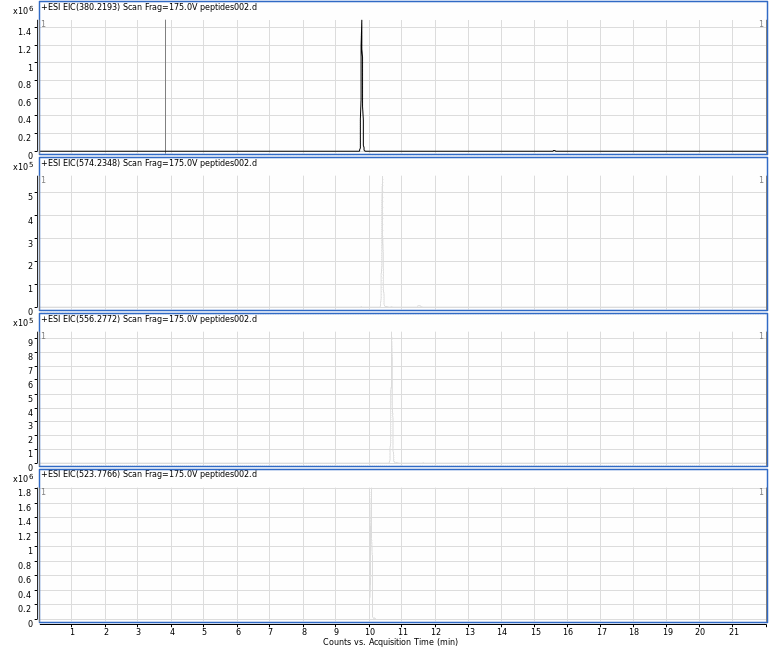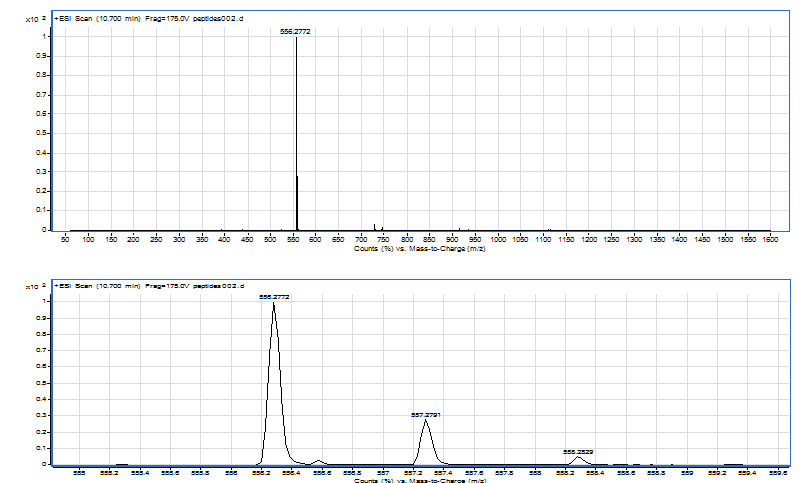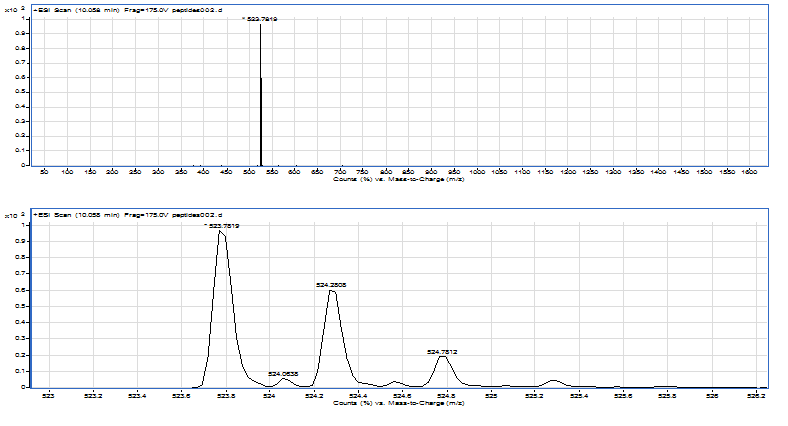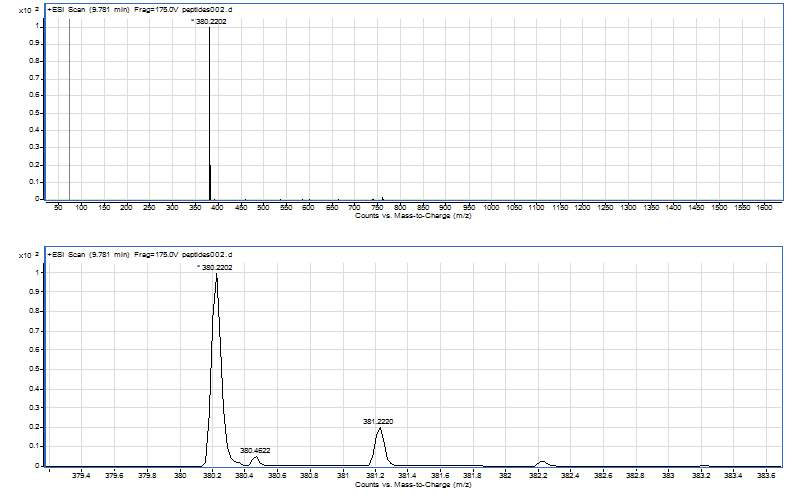Introduction
The purpose of the experiment was to investigate peptides’ behaviour and the manner in which they can be utilized to identify a protein by means of electrospray ionization on an electrospray QTOF mass spectrometer. The peptides were introduced through a high performance liquid chromatography (HPLC) flow pathway. They were chromatographically alienated by HPLC and analyzed immediately using the mass spectrometer, which acquired structural information during the chromatographic run. Specifically, the quadrupole time of flight (Q-TOF) mass spectrometer was used.
Background
Mass spectrometer
Mass spectrometry provides an easy, gentle and robust method for ionizing a broad range of molecules, including small molecules such as drugs, medium-sized molecules such as peptides, and huge proteins. The method is recognized as an excellent ionisation technique, more so for biological applications. The Q-TOF mass spectrometer fits well in peptide analysis. Modern spectrometry is able to achieve electrospray ionization.
Electrospray ionization
A solution is passed via a fine needle held at a high potential and a spray of droplets induced into the solution. The droplets have charged ions such that the charge repulsion between these ions overcomes the droplets surface tension to release ions and create smaller droplets. The process goes on until ions that have no solvent are generated. The protein and peptides were analysed in positive ion mode in a solution containing acetonitrile and water containing 0.1-1 %(v/v) formic acid.
Procedure
Preparations
A stock peptide mixture solution containing 500ug of five different peptides was dissolved in 4ml water. Subsequently, 10ul of peptide solution was diluted to 1 ml with HPLC solution. The samples were then placed in the autosampler vial at a concentration of 1.25ng/ul. The peptides on the HPLC were separated and analyzed using QTOF. The following is the sequence and neutral molecular weight of the 5 sigma peptides:
- GLY-TYR (GY) Mr 238Da
- VAL-TYR-VAL (VYV) Mr 379Da
- TYR-GLY-GLY-PHE-MET (YGGFM) Mr 573Da
- TYR-GLY-GLY-PHE-LEU (YGGFL) Mr 555Da
- ASP-ARG-VAL-TYR-ILE-HIS-PRO-PHE (DRVYIHPF) Mr 1046Da
Protein identification
The experiment utilized the Global Proteome Machine together with a bundled search engine known as XHUNTER to identify a protein. Specifically, the QTOF was utilized to generate peptide mass and peptide MS/MS spectra, information that was relied upon to identify a protein from a database of several validated and curated MS/MS peptide spectra. The protein digest was run on the HPLC QTOF system and then a Mascot generic file was generated from the data (a list of MS/MS and MS events). A search was performed using the XHUNTER and the results saved.
HPLC/MS of peptides
The peptides in the autosampler tray were automatically injected (2ul) onto the liquid stream flow using the autosampler. Solvents A and B were pumped via the column at high pressure by means of two separate pumps. Solvent A is aqueous and polar while solvent B is organic (acetonitrile based) and less polar. The two solvents combined at the mixing tee and the solvent mixture was pumped via the HPLC column together with the peptides. The peptides bind to the column.
Over time, less solvent A and more solvent B passes via the column. As a result, the mobile phase transformations from originally mostly aqueous and polar to mostly organic and more hydrophobic or less polar cause peptides to elute from the column. Note that every peptide elutes at a specific part of the gradient based on the solvents (A: B) proportion. The HPLC gradient was set at 20 minutes long and the total flow during the gradient was 12 ul/minutes.
Results
The results of the mass spectrometer analysis are given by the graphs below.




Bibliography
Ashcroft, Alison E. An Introduction to Mass Spectrometry. 2013. Web.
Brown, Phillis. Advances in Chromatography, Boca Raton, FL: CRC Press, 2001. Print.
Dass, Chhabil. An Introduction to Biological Mass Spectrometry, New York, NY: Wiley, 2002. Print.
Downard, Kevin. Mass Spectrometry: A Foundation Course, London, UK: Royal Society of Chemistry, 2004. Print.
Hancock, William S. Handbook of HPLC for the Separation of Amino Acids, Peptides and Proteins, Boca Raton, FL: CRC Press, 1984. Print.
Hearn, Milton. High-Performance Liquid Chromatography of Proteins and Peptides, London: Elsevier, 1983. Print.
Hughes, George and Kenneth Wilson. “High-performance Liquid Chromatography: Analytic and Preparative Applications in Protein Structure Determination.” Methods of Biochemical Analysis 29.1 (1983): 59-135. Print.
Irving, Helen R. and Chris Gehring. Plant Signaling Peptides. London, UK: Springer Science & Business Media, 2012. Print.
Siuzdak, Gary. The Expanding Role of Mass Spectrometry in Biotechnology, MCC Press, San Diego, 2004. Print.
Trauger, Sunia, William Webb and Gary Siuzdak. “Peptide and Protein Analysis with Mass Spectrometry.” Spectroscopy 16.1 (2002): 15-28. Print.